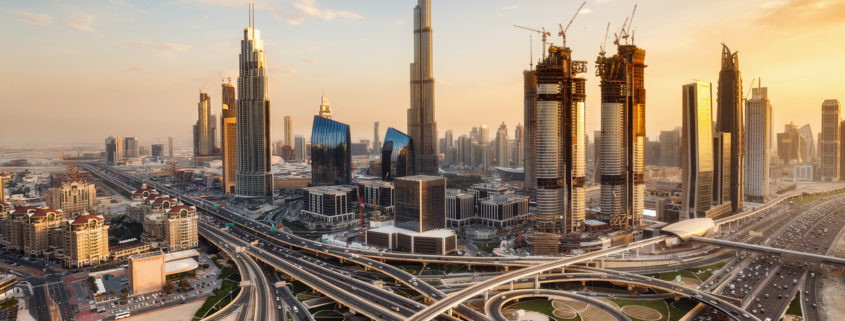Andrew Raymond, Global Head of Sales
Digitisation is high on the agenda in the Middle East and North Africa (MENA) region, with double-digit predictions in the air for the rate at which its market for digital transformation will expand.
Much of the region is experiencing almost 100 per cent rates of smartphone-use, and the consequences of this enthusiasm for personal digital devices is feeding through into business and trade, where younger executives and government leaders are attuned to the opportunities of linking their trade infrastructures into the wider digital world.
With ever-growing emphasis on the importance of reducing dependency on oil export revenues, the Gulf states in particular have responded by compiling digital strategies, setting themselves ambitious targets. Saudi Arabia and Qatar, for example, have Vision 2030 masterplans, while the UAE has Vision 2021. Egypt and Jordan too have their digital strategies.
It is Dubai and the UAE that are generally thought to be at the forefront of digitisation, showing considerable interest in smart city technologies, artificial intelligence and semiconductors. The aim in Dubai is for all government transactions, where possible, to be digital by 2020. Yet Saudi Arabia’s vision includes the National Transformation Program, which places digital transformation as one of the Kingdom’s four main objectives.
It may be true that these countries’ digital economies remain proportionately very small when set against the larger G7 countries, but the Gulf states in particular are not hampered by inadequate broadband connectivity or lack of ICT talent. They also have some forward-looking regulators in the trade and finance sector, who not only understand the challenges, but are backed up by a robust legal system and a willingness to enforce rules.
It makes the MENA region ideally placed to take advantage of the benefits of the digitisation of trade transactions and documentation, removing all the very costly disadvantages of using slow and insecure paper-based processes. They have the opportunity to leapfrog ahead of many other regions, where it is still often the case that natural conservatism and lack of consensus means that the processing of trade documents takes days or weeks instead of the few hours now possible. Not only do paper processes open up all kinds of problems in relation to fraud and accuracy, they are easily lost and very expensive to administer.
The evidence of enthusiasm for trade digitisation was to be seen at GTR MENA Trade & Export Finance Week in Dubai, a major event attended by 600 delegates from 30 countries, including key people many from significant corporates and banks. The energy flowing around the whole digitisation question was unmistakeable.
Right across the region, digitisation is a buzzword, particularly among the banks. Hardly surprising when growing wealth has generated such a welter of import activity that covers everything from materials for massive infrastructure projects to every kind of manufactured product, including luxury goods and vehicles.
That is not to say this a headlong rush. The move to digitisation is being taken step by step with full evaluation of each use case. Many of the MENA region’s decision-makers in international trade have started to adopt digital platforms to benefit from huge gains in speed, security and efficiency. SABB (Saudi British Bank), for example is now bringing electronic trade document solutions to corporate clients, slashing transaction times and delivering major benefits to all parties.
SABB’s adoption of a digital platform last year was a first for trade digitisation in the Kingdom and remains a significant cornerstone of what will be a much larger structure, since the bank is pre-eminent in trade finance within the Kingdom. Similarly, ABB, the Swiss-based leader in power and automation technologies, is proving to be an important corporate relationship in a region where investment in utilities and telecommunications proceeds on a huge scale. In fact, all the banks in the MENA area are increasingly adopting an open-minded approach to the digitisation of trade finance.
It was no accident that so many of the conversations at GTR MENA were about electronic bills of lading and digital presentations, reflecting the changes in attitude sweeping across the region. We could be on the verge of great change, where the trading operations of banks and corporates in the MENA countries become part a “network of networks” enjoying all huge benefits from integration with the ‘Internet of Things’ and similarly far-reaching technological developments that are shaping trade.
Electronic document presentation has already been adopted as far afield as South America, India and Asia, with readily-recognised organisations such as BHP and Rio Tinto using the technology to accelerate secure and trusted execution of transactions in the Far East.
The pace of change, will however, depend very largely on attitudes within governments across the Middle East. As global management consultants McKinsey pointed out, continued organic growth in this region will not be enough to transform it into one of the world’s major digital economies. They went on to say: “Unlocking the full potential of digitisation will require comprehensive, concrete, collaborative action – and it must begin immediately.” That was in 2016, so the time is ripe for all trade transactions to be conducted in the MENA region at the touch of a screen, rather than by couriering old-fashioned paper documents around the world for weeks at a time, where they may be lost, stolen or forged.
Moving to a tried and tested digital trade platform could be a major trigger in the wider digital transformation of the entire region.




